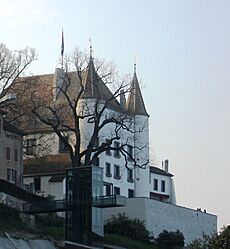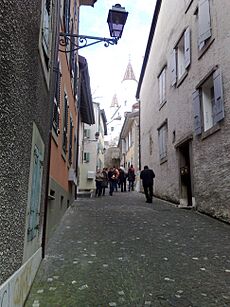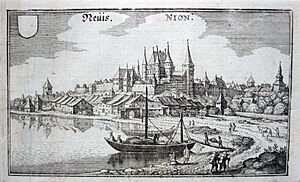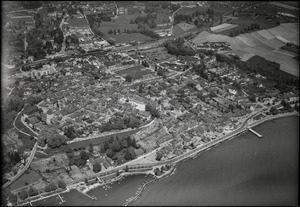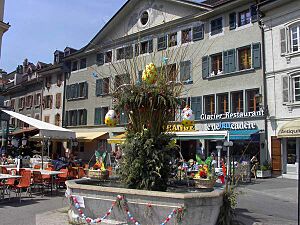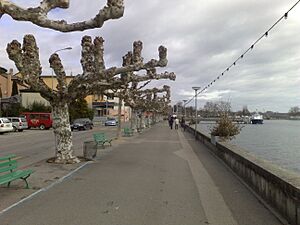Nyon facts for kids
Quick facts for kids
Nyon
|
||
|---|---|---|
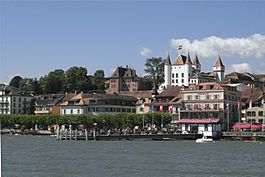
Nyon in late August 2007
|
||
|
||
| Country | Switzerland | |
| Canton | Vaud | |
| District | Nyon | |
| Area | ||
| • Total | 6.8 km2 (2.6 sq mi) | |
| Elevation | 400.9 m (1,315.3 ft) | |
| Population
(Dec 2020 )
|
||
| • Total | 21,718 | |
| • Density | 3,194/km2 (8,270/sq mi) | |
| Postal code |
1260
|
|
| Surrounded by | Crans-près-Céligny, Duillier, Eysins, Grens, Messery (FR-74), Prangins, Signy-Avenex, Trélex | |
| Twin towns | Nyons (France) | |
Nyon is a town in Switzerland, located in the Canton of Vaud. It's about 25 kilometers (15 miles) northeast of Geneva and sits right on the beautiful shores of Lake Geneva. Since the 1970s, Nyon has become part of the larger Geneva area.
Nyon is well-known around the world of sports. It's home to the main offices of the Union of European Football Associations (UEFA). This is the organization that runs football (soccer) competitions across Europe. Nyon is also connected to other parts of Switzerland by major roads and train lines.
Contents
- What's in a Name? The History of Nyon's Name
- A Glimpse into Nyon's Past: A Historical Journey
- Nyon Today: A Hub of Activity
- Nyon's Landscape: Geography and Climate
- Nyon's Symbol: The Coat of Arms
- Who Lives in Nyon? Demographics
- Important Places: Heritage Sites in Nyon
- Nyon's Economy: How People Work and Live
- Faith in Nyon: Religious Life
- Learning in Nyon: Education and Museums
- Sports in Nyon: Football and Rugby
- Famous Faces: Notable People from Nyon
- Getting Around: Transport in Nyon
- Images for kids
- See also
What's in a Name? The History of Nyon's Name
The name Nyon comes from an old Roman name for the town, Noviodunum. The Romans also called it Colonia Iulia Equestris or Colonia Equestris Noiodunum. These names show how important the town was in Roman times.
A Glimpse into Nyon's Past: A Historical Journey
Nyon was first mentioned in old writings between the years 367 and 407 AD. Later, in 1236, it was called Neveduni, and in 1292, it was known as Nyons.
Ancient Times: From Stone Age to Roman City
Some very old tools from the Neolithic period (Stone Age) were found in Nyon. Also, bronze rings and remains of a Bronze Age settlement were discovered north of the city.
Nyon as a Roman Colony: Noviodunum
The Romans founded Nyon between 50 and 44 BC. They named its main part Noviodunum. It grew into one of the most important Roman settlements in what is now Switzerland. The city had a forum (a public square), a basilica (a large public building), and even an amphitheater. The amphitheater was only found recently in 1996, during construction work!
Nyon was part of a network of Roman towns that helped control the Rhone Valley. It also helped keep an eye on the Helvetii people, who had settled in the area after being defeated by the Romans in 58 BC.
The Roman city was built in a grid pattern. It had a grand center with buildings for business, religion, and social life. Parts of this first forum have been found. Over time, under Emperor Tiberius, the forum was made even bigger and more impressive. It had colonnades (rows of columns) and other important buildings.
The amphitheater, built around the early 2nd century AD, had an arena about 50 by 36 meters (164 by 118 feet). It was used for public shows and events. The homes in Nyon were mostly simple, but some larger houses with gardens and pools also existed. An aqueduct about 10 kilometers (6 miles) long brought water to the city from the Divonne area.
The Roman City's Decline
After a long time of peace, problems started appearing in the early 3rd century. Around 259 or 260 AD, invaders called the Alamanni attacked and destroyed the forum and other public buildings. The stones were scattered and reused in other places, especially in Geneva. Even though Nyon lost its importance as a regional capital, people still lived there.
Medieval Nyon: Castles and Charters
During the Carolingian period, Nyon was part of the county of Geneva. Later, it became independent. In 1032, the King of Burgundy gave Nyon to the Archbishop of Besançon, who then granted it to the Lord of Prangins.
The Nyon Castle was first mentioned in 1272, but it was likely built even earlier by the Lords of Prangins. It was rebuilt in 1463 by Louis I of Savoy. A square tower, called César Tower, was also built to protect the town.
In 1293, the Counts of Savoy took over Nyon. They confirmed the town rights that Nyon already had and gave it even more freedoms. Nyon became one of the four important towns of Canton Vaud. In 1294, Louis I of Savoy started to make Nyon a center of his power. He set up a court and a mint, where coins were made.
In 1530, the Swiss Confederation invaded Vaud and took control of Nyon. Then, in 1536, Nyon surrendered to Bern without a fight.
Religious Buildings in Medieval Nyon
- A Benedictine priory (a type of monastery) was founded in Nyon in the early 12th century. It later became an Augustinian monastery.
- A Franciscan monastery was built in 1295–96. Several members of the House of Savoy were buried there.
- The Church of Notre-Dame was built using materials from the Roman period. Its oldest parts date back to the 12th century.
Early Modern Nyon: Trade and Transformation
In 1536, Nyon became an administrative center for Bern. The castle was turned into the home of the local governor. Nyon remained an important place for trade along Lake Geneva and with France and Italy. Goods like grain and wood passed through Nyon, making its customs post very profitable.
In the 18th century, trade and business grew a lot. This led to more markets being held each year. New industries also started, like the Faïencerie Baylon earthenware factory in 1769. Later, a porcelain factory opened in 1781, making Nyon famous for its beautiful ceramics.
Many public buildings were rebuilt or expanded during this time. The medieval city walls were taken down in 1718. The town hall was rebuilt in 1773.
Nyon was also a very active center for the revolutionary movement in the Vaud region. On January 10, 1798, the town refused to obey Bern, leading to the Vaudois revolution. From 1798 to 1803, Nyon was the capital of a district in the Helvetic Republic.
Modern Nyon: Growth and Innovation
In the 19th century, more old fortifications were removed. New housing areas grew around the train station, which was built in 1858. Railways connected Nyon to its surrounding areas. A port was built in 1838 to help with shipping and the growing tourism industry.
Nyon's economy diversified. Besides traditional industries like tanneries and sawmills, new companies emerged. These included a pasta factory, a pharmaceutical company (Zyma, now part of Novartis), and tool factories.
In 1937, Nyon hosted the Nyon Conference, an important meeting about protecting ships in the Mediterranean Sea.
Nyon Today: A Hub of Activity
Nyon is a modern town with a high school, a hospital, a movie theater, and many hotels and restaurants. It's famous for being the home of UEFA, the main organization for football in Europe. It also hosts the international headquarters of UNI Global Union, a global union federation.
Every July, Nyon hosts the Paléo Festival, one of the biggest outdoor music festivals in Europe. Nyon also hosts the Visions du Réel international film festival every April.
Nyon is the regular location for the draws of major football competitions like the UEFA Champions League and UEFA Europa League.
Nyon's Landscape: Geography and Climate
Nyon covers an area of about 6.8 square kilometers (2.6 square miles). A large part of this land is used for farming, and some is covered by forests. Over half of the land is developed with buildings and roads.
The town is located between the Jura Mountains and Lake Geneva. The old part of Nyon is divided into an upper city, built on Roman ruins on a hill, and a lower city along the lake.
Nyon's Weather: A Look at the Climate
Nyon has a mild climate. Here's a quick look at the average temperatures and rainfall:
- Warmest Month: July, with an average temperature around 20.1°C (68.2°F).
- Coldest Month: January, with an average temperature around 1.9°C (35.4°F).
- Rainfall: Nyon gets a good amount of rain throughout the year, with December and November usually being the wettest months.
- Sunshine: The town enjoys plenty of sunshine, especially from May to August.
Nyon's Symbol: The Coat of Arms
The coat of arms of Nyon shows a fish on a red and blue background. This symbol represents the town.
Who Lives in Nyon? Demographics
Nyon has a population of over 23,000 people. Many people from other countries live here, making it a diverse town.
Most people in Nyon speak French, which is the main language. German and English are also commonly spoken.
The population has grown steadily over the years, as shown in the chart below:

Important Places: Heritage Sites in Nyon
Several places in Nyon are considered very important national heritage sites. These include:
- Nyon Castle and its Museum of the History of Porcelain.
- The Roman Colony Iulia Equestris.
- The Swiss Reformed Church of Notre-Dame.
- The Manoir at Rue Maupertuis 2 & 4.
- The Roman Museum.
- The Union of European Football Associations (UEFA) headquarters.
The entire old city of Nyon is also part of the Inventory of Swiss Heritage Sites.
Nyon's Economy: How People Work and Live
Nyon is home to offices for several international companies, including a Swiss publisher, a financial firm, and a medical technology company.
Many people in Nyon work in the service industry, like sales, hotels, restaurants, and healthcare. Others work in manufacturing or construction. Nyon is a place where more people come to work than leave for work, showing it's a busy economic center.
Faith in Nyon: Religious Life
In Nyon, the largest religious groups are Roman Catholic and Swiss Reformed Church members. There are also communities of Orthodox Christians, Muslims, Buddhists, and Hindus, reflecting the town's diverse population.
Learning in Nyon: Education and Museums
Nyon has a good education system. Many people living here have completed higher education. The town has primary and secondary schools.
Nyon is also home to three museums:
- The Musée historique (History Museum)
- The Musée du Léman (Lake Geneva Museum)
- The Musée romain (Roman Museum)
These museums offer great opportunities to learn about Nyon's past and the region's natural history.
Sports in Nyon: Football and Rugby
Nyon is a big name in the world of sports, especially football.
- Football: It's the headquarters of UEFA, which organizes major European football competitions like the Champions League.
- Rugby: The Nyon Rugby Club is one of the top rugby teams in Switzerland.
Famous Faces: Notable People from Nyon
Many interesting people have lived in or come from Nyon, including:
- John William Fletcher (1729–1785), a famous English religious leader.
- Louis Niedermeyer (1802–1861), a composer and teacher.
- Nina Simone (1933–2003), the legendary American singer, lived in Nyon for a time.
- Daniel Rosselat (born in 1953), the founder of the Paléo Festival and the current mayor of Nyon.
- Gaël Monfils (born in 1986), a well-known French professional tennis player.
- Léa Sprunger (born in 1990), a track and field athlete who competed in the Olympics.
Getting Around: Transport in Nyon
Nyon is well-connected by transport. It's a starting point for the Nyon–St-Cergue–Morez Railway, which goes up into the mountains. It's also on the main train line between Geneva and Lausanne. The A1 motorway, a major highway, runs nearby, making it easy to reach Nyon by car.
Images for kids
See also
 In Spanish: Nyon para niños
In Spanish: Nyon para niños





